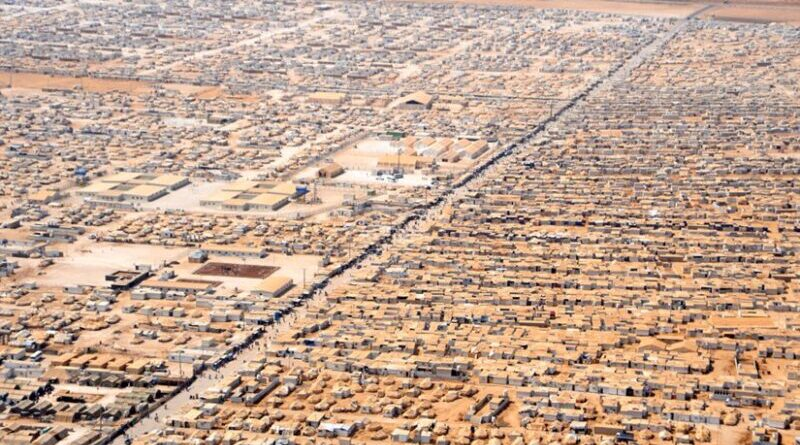
In 2024, 12 percent of “forcibly displaced and stateless people” are expected to be from the Middle East and North Africa (MENA) region, said the United Nations. This displacement will be caused due to war, humanitarian crises, and environmental catastrophes. The number’s recent causes are the civil war in Sudan and the fallout from natural disasters in Turkey, Syria, Morocco, and Libya. This percentage does not include the millions of people in Palestine who have been displaced since 1948.
At Za’atari refugee camp in Jordan, where 20-year-old pregnant Syrian woman Souad lives, children make up 50 percent of the camp’s population of more than 80,000.
“Raising a child in the camp is difficult. There’s limited access to essential resources such as clothing and baby milk formula,” Souad told the Wilson Center, a U.S.-based policy think tank in June 2023.
For a short while in 2013, Za’atari was the fourth-largest city in Jordan and was host to more than 200,000 people from Syria at the time. The population of the 11-year-old refugee camp has since decreased, but with no sign of an end to the conflict in neighboring Syria, Za’atari remains the biggest refugee camp in the Middle East and one of the largest in the world, according to the UN High Commissioner for Refugees (UNHCR). (The vast majority of refugees don’t live in formal camps.)
The UNHCR stated that an estimated 131 million people are projected to be displaced around the world in 2024.
Of the total 131 million people who are projected to be displaced, 63 million are expected to be internally displaced and another 57 million will be refugees or those who are externally displaced, said the UNHCR. As with Za’atari, women and children will make up the vast majority of those who have been displaced.
In 2022, more than three-quarters of the refugees were hosted in low- and middle-income countries, with Turkey leading the way in sheer numbers at 3.6 million followed by Iran at 3.4 million. Meanwhile, “Lebanon hosts the largest number of refugees per capita (one in eight), followed by Jordan (one in fourteen),” stated the Carnegie Endowment for International Peace.
The majority of the refugees in the MENA region are from Syria, where the civil war began in 2011 and continues unabated. More than 5.3 millionrefugees from Syria are in Turkey, Lebanon, Jordan, Iraq, Egypt, and North Africa. Germany also hosts roughly 560,000 Syrian refugees, the most in Europe.
This does not include about 6.8 million internally displaced persons who remain in Syria. About three-quarters of those under the purview of UNHCR in the MENA region were internally displaced, including millions from Yemen’s and Syria’s civil wars.
Za’atari, which features a bustling business thoroughfare known as the Sham Elysees (a play on the Arabic word for Syria and the Parisian avenue Champs-Élysées ), is often highlighted for the “entrepreneurial” spirit of the refugees. But 18-year-old Asia Amari, a resident of the camp, said in 2016 to CNN, “We are not living here, it’s just an existence.”
A visit to another refugee camp for Syrians in Jordan, Azraq, reveals a very different story than the one about a thriving bazaar. Designed as a model camp, Azraq has been characterized as “a heavily controlled, miserable, and half-empty enclosure of symmetrical districts that restricts economic activity, movement, and self-expression.” Refugees have characterized it as an “outdoor prison” and outside observers have called it a “dystopian nightmare.”
Meanwhile, nearly 6 million multigenerational Palestinian refugees fall under the mandate of a different UN body. About 1.5 million Palestinian refugees live in refugee camps in the Gaza Strip, the West Bank, Syria, Lebanon, and Jordan, as well as smaller numbers reside in other MENA countries.
According to the United Nations Relief and Work Agency for Palestine Refugees in the Near East (UNRWA), which oversees the camps for Palestinians, “Socioeconomic conditions in the camps are generally poor, with high population density, cramped living conditions, and inadequate basic infrastructure such as roads and sewers.”
For example, the nearly 488,000 Palestinian refugees in Lebanon are stateless and “have very limited access to public health care, education, or the formal economy,” according to the think tank Migration Policy Institute. Nearly 45 percent of them live in camps. According to the nongovernmental organization Anera, “In some Lebanese camps, when the winter rains come, raw sewage washes into people’s homes.” In 2012, a Lancet study published to assess the health and living situation of Palestinian refugees residing in these camps found that 31 percent had chronic medical conditions and 55 percent experienced “psychological distress.” Not only is gender-based violence a major issue in these camps, but according to UNRWA, “[v]iolent clashes [among various groups] are [also] a regular occurrence.”
In another example of the dire conditions of Palestinians, in Gaza, the poverty rate is more than 80 percent, as is the percentage of people dependent on humanitarian assistance. Meanwhile, the unemployment rate was 47 percent as of August 2022. Anera reports that in 2017, 13 percent of the youth population faced malnutrition. And that was before Israel started its genocidal bombing and invasion campaign.
Like many Palestinians, a lot of refugees retain a strong desire to return to their home country, should conditions once more allow for it to be safe for them to go back. But few have the opportunity—for example, in the first eight months of 2023, less than 25,000 Syrian refugees were able to return to the country.
Others, like Amari, wish to resettle in Europe, Canada, or elsewhere. But for now, they are stuck in squalid camps.
